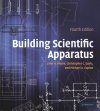Handbook / Manual
By: John H Moore(Author), Christopher C Davis(Author), Michael A Coplan(Author)
647 pages, b/w illustrations, tables
![Building Scientific Apparatus Building Scientific Apparatus]()
Click to have a closer look
About this book
Contents
Customer reviews
Biography
Related titles
About this book
Unrivalled in its coverage and unique in its hands-on approach, Building Scientific Apparatus to the design and construction of scientific apparatus is essential reading for every scientist and student of engineering, and physical, chemical, and biological sciences. Covering the physical principles governing the operation of the mechanical, optical and electronic parts of an instrument, new sections on detectors, low-temperature measurements, high-pressure apparatus, and updated engineering specifications, as well as 400 figures and tables, have been added to this edition.
Data on the properties of materials and components used by manufacturers are included. Mechanical, optical, and electronic construction techniques carried out in the lab, as well as those let out to specialized shops, are also described. Step-by-step instruction supported by many detailed figures, is given for laboratory skills such as soldering electrical components, glassblowing, brazing, and polishing.
Contents
1. Mechanical design and fabrication
2. Working with glass
3. Vacuum technology
4. Optical systems
5. Charged-particle optics
6. Electronics
7. Detectors
8. Measurement and control of temperature
Index
Customer Reviews
Biography
John H. Moore is Professor Emeritus at the University of Maryland. He is a Fellow of the American Physical Society and the American Association for the Advancement of Science. His research has included plasma chemistry, high-energy electron scattering, and the design and fabrication of instruments for use in the laboratory and on spacecraft.
Christopher C. Davis is Professor of Electrical and Computer Engineering at the University of Maryland. He is a Fellow of the Institute of Physics, and a Fellow of the Institute of Electrical and Electronics Engineers. Currently his research deals with free space optical and directional RF communication systems, plasmonics, near-field scanning optical microscopy, chemical and biological sensors, interferometry, optical systems, bioelectromagnetics, and RF dosimetry.
Michael A. Coplan is Professor and Director of the Chemical Physics Program at the University of Maryland. He is a Fellow of the American Physical Society and has research programs in space science, electron scattering, and neutron detection.
Handbook / Manual
By: John H Moore(Author), Christopher C Davis(Author), Michael A Coplan(Author)
647 pages, b/w illustrations, tables
"This new edition includes updates throughout, and will continue to serve as a bookshelf standard in laboratories around the world. I never like to be too far from this book!"
– Jason Hafner, Rice University, Houston, Texas
"[...] the first book I reach for to remind myself of an experimental technique, or to start learning a new one. With valuable additions [...] , the newest addition will be a welcome replacement for our lab's well-thumbed previous editions of BSA."
– Brian King, McMaster University, Canada
"[...] a mine of useful information ranging from tables of the properties of materials to lists of manufacturers and suppliers. This book would be an invaluable resource in any laboratory in the physical sciences and beyond."
– George King, University of Manchester
"[...] concentrating several careers' worth of equipment-building experience into a single volume – a thoroughly revised and updated edition of a 25-year-old classic. It is a 'must-have' on the shelf of every research lab."
– Nicholas Spencer, Eidgenössische Technische Hochschule, Zürich
"This book is a unique resource for the beginning experimenter, and remains valuable throughout a scientist's career. Professional engineers I know also own and enjoy using the book."
– Eric Zimmerman, University of Colorado at Boulder, Colorado
"[...] a fascinating and extremely useful reference work. Anyone who works with scientific apparatus will benefit from this book, undergraduate students, professors, technicians and postdocs. If you do not have one already, buy one now!"
– Contemporary Physics



































